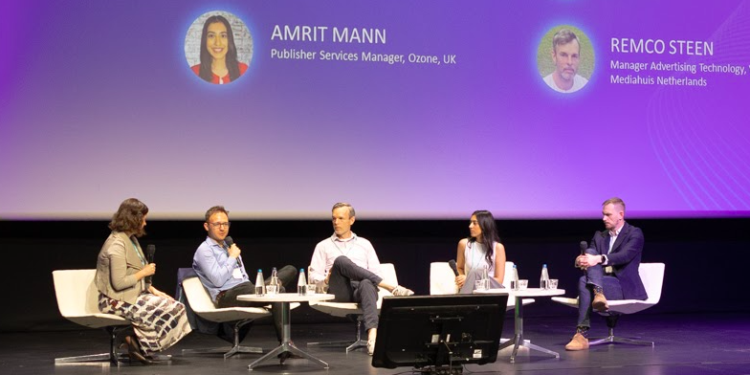WAN-IFRA’s World Press Trends Report 2024-2025, found that publishers continue to look for ways to diversify their revenue. However, advertising still plays a major role in paying for quality journalism.
During a panel at our World News Media Congress in Krakow, news publishers discussed how to optimise your tech stack and how that can drive higher digital advertising returns.
 The challenges in a lower traffic era – Publishers continue to experience downward pressure on audience acquisition because of changes in social and search algorithms, Amrit Mann, the publisher services manager at Ozone, said.
The challenges in a lower traffic era – Publishers continue to experience downward pressure on audience acquisition because of changes in social and search algorithms, Amrit Mann, the publisher services manager at Ozone, said.
Added to the algorithm changes, Google’s AI summaries have reduced clickthrough rates by 34.5%, ahrefs found in an analysis of 300,000 keywords.
 Roll out a cookie wall – Some 40% of users were rejecting all cookies, which had a “devastating” impact on advertising revenue, said Remco Steen, the manager of advertising technology, yield and data, for Mediahuis in the Netherlands. Joining a growing number of publishers, they rolled out a cookie wall that asks users who reject cookies to pay for an ad-free experience. Approaches to cookie walls differ. Some ask users to pay, and others offer options that include registration, which offers up the opportunity for publishers to gain first-party data about those users.
Roll out a cookie wall – Some 40% of users were rejecting all cookies, which had a “devastating” impact on advertising revenue, said Remco Steen, the manager of advertising technology, yield and data, for Mediahuis in the Netherlands. Joining a growing number of publishers, they rolled out a cookie wall that asks users who reject cookies to pay for an ad-free experience. Approaches to cookie walls differ. Some ask users to pay, and others offer options that include registration, which offers up the opportunity for publishers to gain first-party data about those users.
 Your relationship with your audience is important – Some publishers are putting messaging in their cookie walls that communicates to audiences “the money you can generate through ads can be reinvested into journalism,” Mann said, adding that publishers should “foster strong relationships with readers and users so they understand how their constent allows them to continue to receive free and trusted news”.
Your relationship with your audience is important – Some publishers are putting messaging in their cookie walls that communicates to audiences “the money you can generate through ads can be reinvested into journalism,” Mann said, adding that publishers should “foster strong relationships with readers and users so they understand how their constent allows them to continue to receive free and trusted news”.
 Simplify to increase advertising revenue – Some publishers have added more supply-side platforms to their sites. However, publishers need to evaluate the platforms they use and eliminate low-performing ones. You should “confirm if you add more revenue rather than more latency,” Marcin Hadjuk, the chief product officer of Yieldbird said. Mann said that one publisher increased their ad yield by 30% by dropping their lowest-performing SSPs.
Simplify to increase advertising revenue – Some publishers have added more supply-side platforms to their sites. However, publishers need to evaluate the platforms they use and eliminate low-performing ones. You should “confirm if you add more revenue rather than more latency,” Marcin Hadjuk, the chief product officer of Yieldbird said. Mann said that one publisher increased their ad yield by 30% by dropping their lowest-performing SSPs.
 Evangelise about the brand safety of news content – A member of the audience asked how to allay concerns from advertisers about brand safety concerns about news content.
Evangelise about the brand safety of news content – A member of the audience asked how to allay concerns from advertisers about brand safety concerns about news content.
Steen said that Mediahuis in the Netherlands had this problem three to five years ago, but they worked to evangelise the brand safety of advertising against their content. They provided advertising buyers with data that demonstrated the brand safety and performance even on ads on hard news. They have won the argument.
 Consider high-yield formats – Steen said another way to increase advertising revenue is to focus on higher yield formats, especially video and audio. And as other sessions at the Congress demonstrate, audio and video engage younger audiences at higher rates.
Consider high-yield formats – Steen said another way to increase advertising revenue is to focus on higher yield formats, especially video and audio. And as other sessions at the Congress demonstrate, audio and video engage younger audiences at higher rates.
This story was first published by the World Association of News Publishers.
Kevin Anderson is the App Strategy and Industry Insights Director for Pugpig.
WAN-IFRA has announced Marseille as the host city for its next World News Media Congress, from 1-3 June 2026. This choice marks a historic return to France, more than 30 years after the last edition held in Paris in 1995. The Congress will be co-hosted by French media group CMA Media.




















